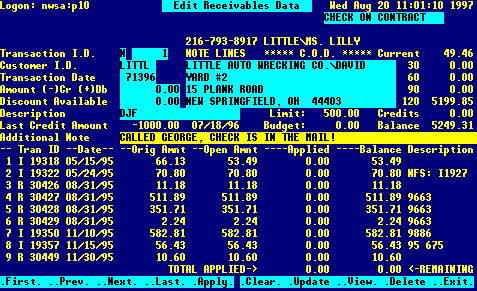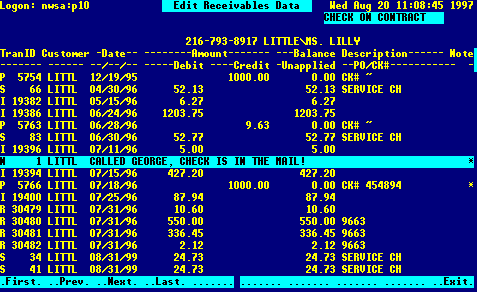Introduced in Version 2.19 of INFONETICS software is an interesting new feature for managing the collections of Accounts Receivables. It’s called the Receivables Notes feature, and permits logging of in-line notes in each customers Receivables Transaction history. These notes appear on view screens, Agings, Inquiries and Journals, and are therefore perhaps more useful than the generic Customer Notes file associated with the customer’s master records.
 CREATING NEW NOTE LINES
CREATING NEW NOTE LINES
To create note line entries on a customers account, simply post them to their acocunt as you would any other payment or adjusting transaction using “Edit Receivables Data”. Use the transaction type ‘N’ (Note Line) to differentiate it from other types of transactions in the database. Leave the Transaction Number zero so the system creates a new note line, and make sure to date the transaction appropriately so it appears in the correct chronological order within the account.
It’s very important to not enter any dollar amount on the transaction, as that will prevent the note from being displayed on the Receivables History view screen.We suggest entering your initials in the Description field (over top of the default verbage of “CK#”), and of course enter whatever message you find appropriate in the new “Additional Note” field.
 NOTES ON PAYMENTS
NOTES ON PAYMENTS
Notes can also be associated with other types of transactions, like payments. While posting, you may now put a note on the transaction explaining any special circumstances of the payment (ie; “SHORT PAID TAX, FREIGHT….”). While this note doesn’t appear on the view screen (since it has money associated with it), it is flagged with an asterix (*) in the Note column of the view screen.
NOTES APPEAR ON REPORTS
Beware that these notes do appear on most receivables reports, including the Aging and Inquiries. For this reason these reports are probably no longer appropriate to print and/or fax to customers. Be accurate, polite and discrete in the wording of your notes though, just in case one of these reports happens to fall into their hands.
NOTES DON’T APPEAR ON STATEMENTS
Of course, the Receivables Statements will not show any additional notes lines, as this document is destined for the customers eyes. It is really the only appropriate document available to be sent/faxed to the customer.
CONCLUSION
As you can see, this powerful new feature gives you the ability to more closely monitor/track communication with delinquent customers, and in a more convenient way than the generic Customer Notes feature offered.
